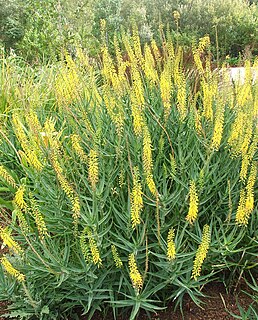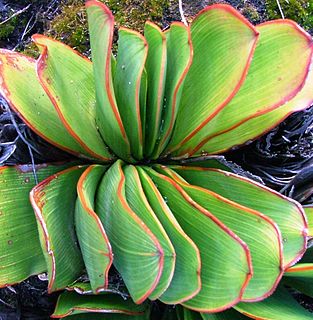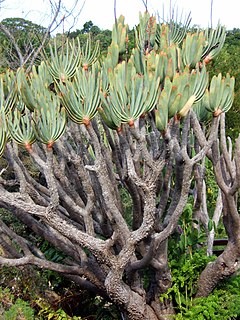
Aloe, also written Aloë, is a genus containing over 550 species of flowering succulent plants. The most widely known species is Aloe vera, or "true aloe". It is called this because it is cultivated as the standard source for assorted pharmaceutical purposes. Other species, such as Aloe ferox, are also cultivated or harvested from the wild for similar applications.

Gonialoe variegata, also known as tiger aloe and partridge-breasted aloe, is a species of flowering plant in the family Asphodelaceae. It is an evergreen succulent perennial indigenous to South Africa and Namibia. It is common in cultivation.

Aloe arborescens, the krantz aloe or candelabra aloe, is a species of flowering succulent perennial plant that belongs to the genus Aloe, which it shares with the well known and studied Aloe vera. The specific epithet arborescens means "tree-like". Aloe arborescens is valued by gardeners for its succulent green leaves, large vibrantly-colored flowers, winter blooming, and attraction for birds, bees, and butterflies.

Aloidendron barberae, formerly Aloe bainesii and Aloe barberae, also known as the tree aloe, is a species of succulent plant in the genus Aloidendron. It is native to South Africa northwards to Mozambique. In its native climes this slow-growing tree can reach up to 60 feet (18 m) high and 36 inches (0.91 m) in stem diameter. Aloidendron barberae is Africa's largest aloe-like plant. The tree aloe is often used as an ornamental plant. Its tubular flowers are rose pink (green-tipped); it flowers in winter and in its natural environment is pollinated by sunbirds.

Aloe succotrina, the Fynbos aloe, is an aloe which is endemic to Cape Town and the south-western corner of the Western Cape, South Africa.

Aloe polyphylla, the spiral aloe, kroonaalwyn, lekhala kharetsa, or many-leaved aloe, is a species of flowering plant in the genus Aloe that is endemic to the Kingdom of Lesotho in the Drakensberg mountains. An evergreen succulent perennial, it is well known for its strikingly symmetrical, five-pointed spiral growth habit.

Aloe striata, with the common name coral aloe, is a small, stemless South African Aloe species.

Aloiampelos commixta is a flowering plant in the Asphodelaceae family. It is commonly called Table Mountain aloe, and is a rare succulent plant that is endemic to the Cape Peninsula, South Africa. It naturally occurs only on the Table Mountain range, within the city of Cape Town.

Aloiampelos striatula, formerly Aloe striatula, the hardy aloe or striped-stemmed aloe, is a sturdy succulent plant that naturally occurs on the summits of mountains along the south of the Karoo region of South Africa. Tough and hardy, with bright yellow flowers, it is a popular plant in gardens around the world.

Aloiampelos tenuior, formerly Aloe tenuior, the fence aloe, is a bushy, multi-branched succulent plant from the grasslands and thickets of the Eastern Cape, Kwazulu Natal and Mpumalanga, South Africa. Its preferred habitat is sandy soils in open country, unlike many of its relatives that favour thicket vegetation. It is one of the most profusely flowering of all aloes and their relatives.

Aloiampelos gracilis, formerly Aloe gracilis, the rocket aloe, is a succulent plant, endemic to dry thicket vegetation around the city of Port Elizabeth, South Africa. Its natural range lies just to the west of the related Aloiampelos ciliaris, and it occurs in bushy fynbos and dry thickets, and clustered on rocky outcrops at all altitudes. Its range extends westwards into the Baviaanskloof mountains.

Kumara haemanthifolia is a species of flowering plant in the family Asphodelaceae. It is a rare species of succulent plant, native to a few high, inaccessible mountain peaks in the Fynbos habitat of Western Cape, South Africa.

Aloiampelos, formerly Aloe ser. Macrifoliae is a genus of succulent plants in the subfamily Asphodeloideae, comprising seven species found in Southern Africa. They are typically multi-branched climbing or sprawling shrubs, with long spindly stems and a large woody base on the ground. These characteristics, as well as their soft, narrow, triangular leaves whose lower part ensheathes the stem, make them easy to distinguish.

Aloe brevifolia, the short-leaved aloe, is a species of flowering plant in the family Asphodelaceae. It is a tiny, compact, blue-green evergreen succulent perennial, that is native to the Western Cape, South Africa. Listed as Vulnerable on IUCN's global Red List, it is threatened in its natural habitat, but is also widely popular as an ornamental plant in rockeries and desert gardens worldwide. As it requires winter heat, in temperate regions it is grown under glass or as a houseplant.

Kumara is a genus of two species of flowering plants in the subfamily Asphodeloideae, native to the Western Cape Province of South Africa.

Aloe speciosa is a species of flowering plant in the Asphodelaceae family. It is commonly called tilt-head aloe and is an arborescent aloe indigenous to the thicket vegetation of the southern Cape Provinces of South Africa.

Gasteria baylissiana, Suurberg gasteria, is a species of succulent flowering plant in the family Asphodelaceae, native to the Eastern Cape, South Africa.

Tulista pumila ("Vratjiesaalwee") is a species of Tulista succulent plant, from the Western Cape, South Africa.

Aloeae is a tribe of succulent plants in the subfamily Asphodeloideae of the family Asphodelaceae, consisting of the aloes and their close relatives. The taxon may also be treated as the subfamily Alooideae by those botanists who retain the narrower circumscription of Asphodelaceae adopted prior to the APG III system. Typically, plants have rosettes of more or less succulent leaves, with or without a distinct stem. Their flowers are arranged in racemes and tend to be either small and pale, pollinated by insects, or larger and more brightly coloured, pollinated by birds. As of 2017, 11 genera are recognized, most created since 2010 by splitting off another five genera from Aloe and another two from Haworthia. Only two genera, Aloe and Aloidendron, are native outside southern Africa, extending northwards to the Arabian Peninsula. Seven genera are restricted to South Africa, some with small ranges. Members of the Aloeae are cultivated by succulent plant enthusiasts; Aloe species especially are used in temperate climates as ornamental garden plants. Some species are used in traditional medicine. Aloe vera and Aloe ferox are cultivated for their extracts, whose uses include moisturizers and emollients in cosmetics.
× Gonimara is a genus of hybrid plants, from a mixture of species from the Gonialoe and Kumara genera. Only a single hybrid is recorded for this mixture however, × Gonimaracorderoyi, an unusual and reputedly very attractive aloe hybrid, recorded as being produced by pollination between Gonialoe variegata and Kumara plicatilis.

























